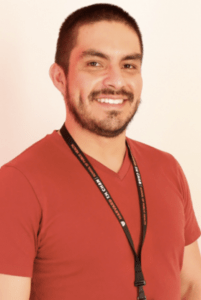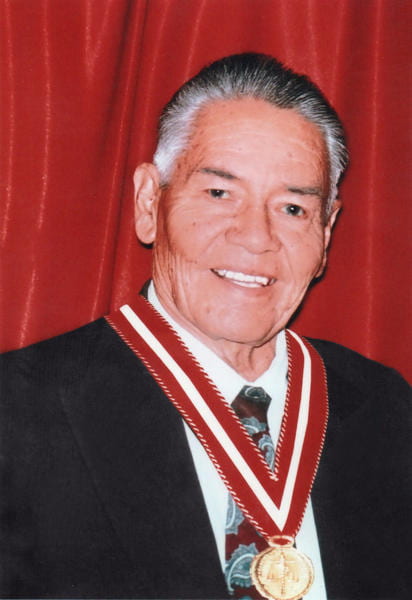
About the Author
Carlos Zegarra Zamalloa, a native of Peru, is a MPH Global Health candidate at the Harvard T. H. Chan School of Public Health.
Acerca del Autor
Carlos Zegarra Zamalloa, oriundo de Perú, es candidato a MPH Global Health en la Escuela de Salud Pública T. H. Chan de Harvard.
Terrorism in Peru
Our Historical Memory
One peaceful August morning in 1991, my grandfather, Orlando Zamalloa, was getting ready to go to work in Cusco, a small city in southern Peru. He had been dividing his time between the town courts where he worked as a lawyer, and the university, where he advised law students. That day, while my grandmother was preparing breakfast, they heard a knock on the door. The visitors claimed they were his law students.
My grandfather sensed that something was not right as he approached and opened the door; he noticed that one of the students was hiding behind the wall. It was too late to react. They shot him seven times before fleeing and leaving him to bleed out and die. My grandfather was taken to the hospital to begin a painful process of recovery and severe health consequences that lasted until his death from liver cancer in 2007. The liver cancer was a result of the blood transfusion he received during his recovery from the assault. And the attackers? Terrorists of the Tupac Amaru Revolutionary Movement (MRTA), a group in force in Peru that destroyed the country, particularly during the decade of the 80s and 90s.
My grandfather represents in a certain way all that which the terrorists wanted to destroy: justice, that my grandfather sought every day in his work as a lawyer, and the peace of our families and society. This is why I object to this tumultuous time being called “a civil war,” whether in the name of a university conference or in the media. Let me explain further.
Nowadays, I feel that some segments of the population and especially the new generations have forgotten how difficult that time was. Along with this, there is a growing discussion in Peru about whether that part of our history should be called “terrorism,” “internal armed conflict” or “civil war.”
We should have things clear; the only goal of terrorism was to get power in any way and at any cost. Proof of this is that even though at one point they declared having an ideology, nowadays they seek to obtain it through an evil alliance with drug trafficking.
In the case of terrorism in Peru, to a large extent, its strategy was based on causing the most significant harm to the population outside of the power structures, to produce fear and anxiety in the country, with the assassination of innocent people. The destruction of infrastructure, the killing of leaders, politicians, military, and police officers, as well as their desire to cause a psychological impact that undermines a country’s self-esteem were their primary weapons.
Massacres in places like Lucanamarca, Uchuraccay or Tarata bear witness to the legacy of destruction and death that these two terrorist organizations left during those years, with an estimated number of 69,280 people, between civilians and terrorists, as a result of the fight of the army and police against terrorists in different regions of Peru.
Those of us who lived through that time cannot forget the ever-present dangers and threats that made us all hesitate to open our front doors to welcome others in; the kidnappings of prominent businesspeople, village massacres of peasants, military assassinations, car bombs and power outages were in the news every day. We lived with the post-traumatic fear of uncertainty: in a state of constant unrest over who or what is next?
In areas such as public health, the presence of these groups in rural areas was a barrier to the implementation of health activities such as vaccination and eradication of diseases. Peru was the last country in America to eradicate polio—the last case occurred in 1991 in Junin (Central Sierra). Terrorist violence generated fear among volunteers in charge of vaccinations, and the destruction of health posts limited the action of doctors and nurses committed to vaccination campaigns. They attacked the volunteers and charged fees to the doctors in charge of the vaccinations.
In addition, the massive migrations from the countryside to the city, as a product of fear and violence, resulted in the creation of large areas in the peril of the cities, leading to precarious living conditions. The lack of water, electricity and health services caused the indexes of morbidity (presence of disease in the population) and mortality in areas of low resources to be unusually high.
We see how terrorism destroyed our country in many aspects, not only politically and economically, but also prevented the improvement of health conditions in the population. Is it appropriate to call this time “civil war”? Trying to equate these groups in terms of values and purposes with the Peruvian state seems wrong to me. There is nothing civil in killing or kidnapping people, preventing access to health for the poorest, and using fear to reach power by all means. Let’s be clear, what happened in Peru was terrorism.
If you liked this article, click here to read related articles from our issue on Peru!
Terrorismo en Perú
Nuestra memoria histórica
Por Carlos Zegarra Zamalloa
Una tranquila mañana de agosto de 1991, mi abuelo, Orlando Zamalloa, se estaba preparando para ir a trabajar en Cusco, una pequeña ciudad en el sur de Perú. Había estado dividiendo su tiempo entre los tribunales de la ciudad donde trabajaba como abogado, y la universidad, donde asesoraba a los estudiantes de derecho. Ese día, mientras mi abuela estaba preparando el desayuno, escucharon que llamaban a la puerta. Los visitantes indicaron que eran estudiantes de derecho.
Mi abuelo sintió que algo no estaba bien cuando se acercó y abrió la puerta; notó que uno de los estudiantes se escondía detrás de la pared. Era demasiado tarde para reaccionar. Le dispararon siete veces antes de huir y dejar que se desangrara. Mi abuelo fue llevado al hospital para comenzar un doloroso proceso de recuperación y graves consecuencias para la salud que duraron hasta su muerte por cáncer de hígado en 2007. El cáncer de hígado fue el resultado de las transfusiónes de sangre que recibió durante su recuperación. ¿Y los atacantes? Terroristas del Movimiento Revolucionario Tupac Amaru (MRTA), un grupo vigente en el Perú que destruyó el país, especialmente durante la década de los 80 y 90.
Mi abuelo representa de cierta manera todo lo que los terroristas querían destruir: la justicia, que mi abuelo buscaba todos los días en su trabajo como abogado, y la paz de nuestras familias y la sociedad. Por eso me opongo a que esta época tumultuosa sea llamada “guerra civil”, ya sea en nombre de una conferencia universitaria o en los medios de comunicación. Permitanme explicar un poco mas.
Hoy en día, siento que algunos segmentos de la población y especialmente las nuevas generaciones han olvidado lo difícil que fue esa época. Además de ello, hay una creciente discusión en Perú sobre si esa parte de nuestra historia debería llamarse “terrorismo”, “conflicto armado interno” o “guerra civil”.
Debemos tener las cosas claras; El único objetivo del terrorismo era obtener poder de cualquier manera y a cualquier costo. Prueba de ello es que, aunque en un momento haya declarado tener una ideología, hoy en día buscan obtener el poder a través de una alianza perversa con el narcotráfico.
El terrorismo en el Perú, en gran medida, basó su estrategia en causar el mayor daño posible a la población fuera de las estructuras de poder, para producir temor y ansiedad en el país, con el asesinato de personas inocentes. La destrucción de la infraestructura, el asesinato de líderes, políticos, militares y oficiales de policía, así como su deseo de causar un impacto psicológico que socavara la autoestima de un país eran sus armas principales.
Las masacres en lugares como Lucanamarca, Uchuraccay o Tarata son testigos del legado de destrucción y muerte que dejaron estas dos organizaciones terroristas durante esos años, con un número estimado de 69,280 personas, entre civiles y terroristas, como resultado de la lucha del ejército. y policías contra terroristas en diferentes regiones del Perú.
Aquellos que vivimos ese tiempo no podemos olvidar los peligros y amenazas siempre presentes que nos hicieron sentir temor al abrir nuestras puertas para recibir a otros; los secuestros de prominentes empresarios, las masacres de campesinos, los asesinatos de militares, los coches bomba y los cortes de energía. Vivimos con el miedo postraumático a la incertidumbre: ¿en un estado de inquietud constante sobre que o quién es el siguiente?
En áreas como la salud pública, la presencia de estos grupos en áreas rurales fue una barrera para la implementación de actividades de salud como la vacunación y la erradicación de enfermedades. El Perú fue el último país de América en erradicar la poliomielitis; el último caso ocurrió en 1991 en Junín (Sierra Central). La violencia terrorista generó temor entre los voluntarios a cargo de las vacunas, y la destrucción de los puestos de salud limitó la acción de los médicos y enfermeras comprometidos con las campañas de vacunación. Atacaron a los voluntarios y cobraron cupos a los médicos a cargo de las vacunaciones.
Asimismo, las migraciones masivas del campo a la ciudad, como producto del miedo y la violencia, dieron lugar a la creación de grandes asentamientos en la periferia de las ciudades, lo que llevó a condiciones de vida precarias. La falta de agua, electricidad y servicios de salud provocó que los índices de morbilidad (presencia de enfermedades en la población) y la mortalidad en áreas de bajos recursos fueran inusualmente altos.
Vemos cómo el terrorismo destruyó nuestro país en muchos aspectos, no solo política y económicamente, sino que también impidió la mejora de las condiciones de salud en la población. ¿Es apropiado llamar a esta época “guerra civil”? Tratar de equiparar estos grupos en términos de valores y propósitos con el estado peruano no me parece correcto. No hay nada civil en matar o secuestrar personas, dificultar el acceso a la salud para los más pobres y utilizar el miedo para alcanzar el poder por todos los medios. Seamos claros, lo que sucedió en el Perú fue el terrorismo.
More Student Views
Post-Secondary Education Access in Peru
Over the summer, I visited four public schools in Peru located in two regions, about 1,200 miles apart from each other. I interviewed teachers, principals and high school juniors and seniors. I wanted to discover their perspectives on perceived opportunities and barriers for students to plan for and fulfill their higher education goals. I also interviewed the superintendent at each school district to learn about local initiatives aimed at decreasing barriers to higher education transition.
The Opacity of Cuba’s La Habana Vieja
On a recent trip to Havana, two fellow visitors reminded me what it feels like to encounter the Cuban city for the first time and to become enamored with its paradoxes. The first, a young Kansan woman in my Airbnb, learning that I study Cuban architecture and urbanism, expressed a familiar curiosity about the dramatic contrast between austere 19th century mansions, colonial palaces and the surrounding blocks of ruinous buildings. The second, a Berliner, shared ceviche with me on a restaurant balcony overlooking a street bustling with tourists and art vendors. He pointed out with a laugh that our utensils came from Air France first class.
It’s Time For Women
“I believe we are in an exacerbated crisis of non-guarantee of women’s rights throughout the country, with the peculiar characteristic of finding ourselves in a moment of different rhetoric — of it being the time of women — because we now have the first woman president, seventy years after women gained the right to vote in this country,” said my interviewee, an organizer for a women’s rights organization in Oaxaca.




